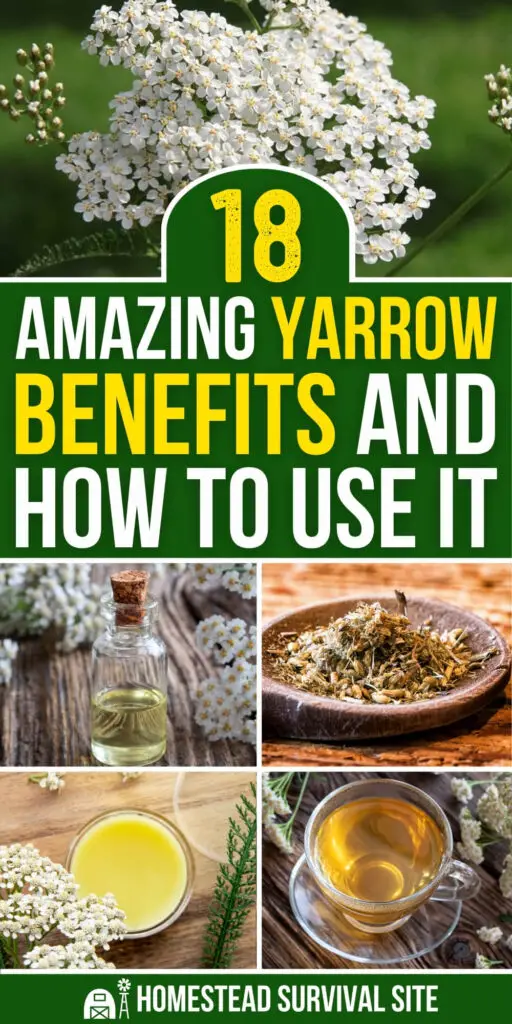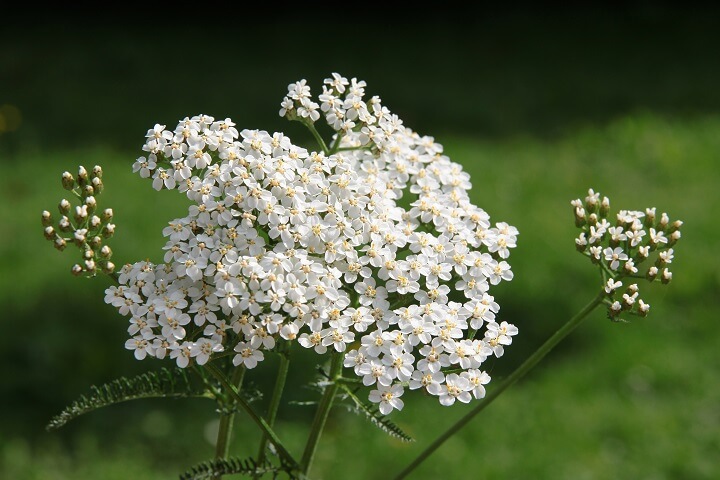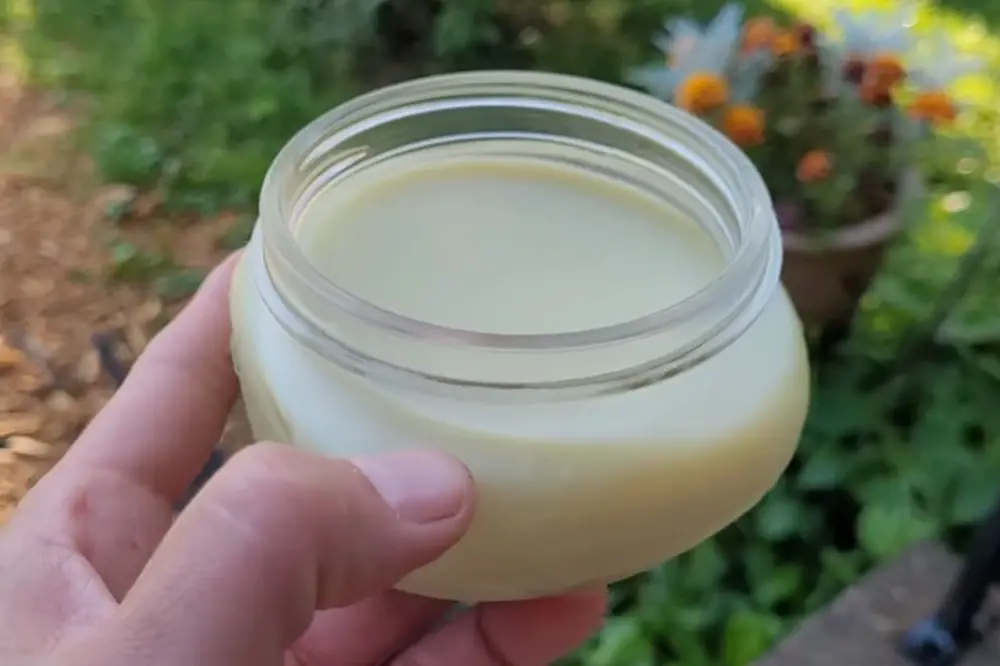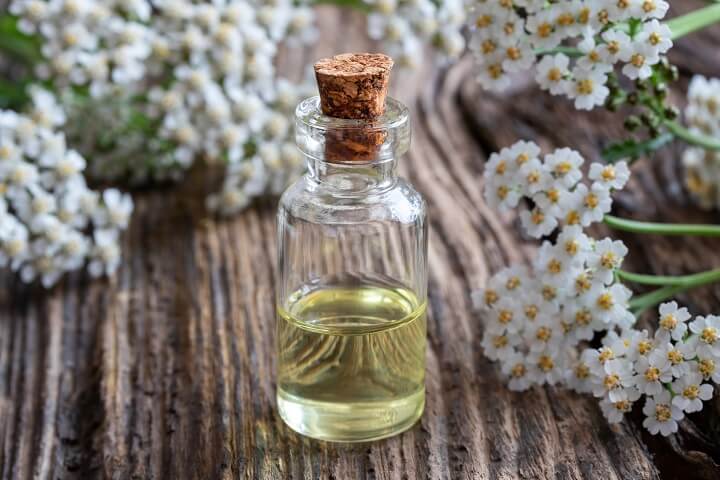Estimated reading time: 14 minutes
Disclaimer: I am not a medical doctor and nothing in this article should be taken as medical advice. Please talk to your doctor before using any of the herbs and/or remedies mentioned in this article.

Yarrow is one of the oldest medicinal herbs, dating back thousands of years and used for various ailments. It's a member of the aster family, along with chamomile and chrysanthemums; it's quite a famous and beautiful flower family. You can find yarrow growing in gardens and along roadsides and throughout meadows.
Yarrow didn't start as a native North American plant. It originated in Europe and western Asia, but it was introduced and naturalized to Australia, New Zealand, and North America over time.
Are you interested in learning more about this ancient medicinal herb? Let’s take a peek at its history and how you can use it today.
The History of Yarrow
Legend tells us that yarrow, technically called Achillea millefolium, was named after Achilles, a Greek mythical hero, who used this herb to stop bleeding wounds on his soldiers during the Trojan war in 1200 B.C. Herbal legend says that Chiron, a centaur, taught Achilles how to use this herb.
Whether or not that is true, the world will never know, but we do know that healers placed rolled yarrow leaves into the nose of those who were bleeding throughout medieval times. Achilles might not have used it, but yarrow did have a place on the battlefield as a clotting agent.
That’s not the only place we see yarrow in history. We know that the Persians used yarrow to stop hemorrhaging, treat pneumonia, and heal wounds as detailed throughout their accounts.
The name “yarrow” is an Anglo-Saxon word that means “to prepare” because it was used as a curative herb. Even today, there are modern medicinal uses for yarrow. It's used as a curative remedy for malaria, jaundice, and liver disorders throughout the world.
Yarrow was even used during World War II in England when the country experienced a shortage of needed medical supplies. Officials encouraged citizens to forage for wild yarrow to supplement the depleted supplies required for their soldiers.
Yarrow in Folklore and Spiritual Practice
Yarrow has long held a place in spiritual and magical traditions. In ancient China, yarrow stalks were used in the I Ching for divination. In Europe, yarrow was often placed under pillows to bring dreams of one’s future spouse or used in wedding bouquets to symbolize lasting love.
It was also believed to offer protection from evil spirits and negativity, making it a popular herb to burn or hang in doorways. Some traditions used it in purification rituals or to “cut” negative ties due to its strong association with boundaries and healing.
Today, some still use yarrow in smudging blends, energy cleansing, or herbal sachets for its reputed energetic protection.
Growing Yarrow in Your Backyard Garden
No herb garden is truly complete without yarrow. Many view it as a weed, but when grown purposefully and tended well, it is a gorgeous addition that will attract pollinators to your home.
Many people think that yarrow only comes in white, but it actually grows in multiple shades, such as pink, purple, red, and yellow. It can be like a yarrow rainbow in your yard, but white is the most commonly chosen color you will see growing wild. No matter the color that you select, they all have the same medicinal properties.

Here is some basic information about how to grow yarrow in your herb garden.
- Understand that yarrow is a hardy perennial with rigorous growth that will push out its neighbors unless you prune and trim as needed.
- Plant yarrow in the spring or early summer once the danger of frost has passed.
- It prefers to grow in a lot of sunlight, but yarrow can handle partial shade. However, if the spot has too much shade, it will cause the stems to become floppy and fall over.
- While yarrow grows in nearly any soil, including poor dirt, it prefers loamy and sandy soil, but its pH varies.
- It's best not to put too much fertilizer or compost into your soil because it will cause rapid, overenthusiastic growth. Then, your plants will require staking. Find an area with poor soil and add just a bit of compost to give the plants a starter boost.
Yarrow as a Companion Plant
In addition to its medicinal value, yarrow is a beneficial companion plant in the garden. It attracts pollinators like bees and butterflies, but it also draws in predatory insects such as ladybugs, lacewings, and parasitic wasps — all of which help control aphid and caterpillar populations.
Yarrow also improves the health of nearby plants by increasing their essential oil content, which is especially useful when planted near aromatic herbs like basil, rosemary, or lavender. Its deep roots pull up nutrients from the soil, acting almost like a natural fertilizer for neighboring plants.
Because of its hardiness and resilience, yarrow is often used as a border or ground cover to prevent soil erosion and help retain moisture in dry climates.
Harvesting Yarrow Properly
The great thing about yarrow is that it's an easy to grow herb that isn't picky about conditions. Harvesting is even easier; you need to let the plant grow to maturity. The leaves, stems, and flowers all contain medicinal properties, so don't waste any of the plants.
- When the flowers open fully, harvest each stem with a sharp pair of garden scissors or a garden knife. Harvest all the way down to the ground.
- Hang the stems with the flower head attached upside in your house or somewhere dry for several days or up to a week.
- After that, you can crumble up the herb and store it in an airtight container. Yarrow stays good for up to one year.
- You can harvest and use the root, but you need to allow the plant to mature for 2-3 years before harvesting it. Another option is to gather small bits of the root each year. It will need to dry for at least a week before storing it.
What Ailments Yarrow Can Treat
Just because yarrow has a long history doesn't mean it's not still a valuable medicinal herb today; it indeed is. No medicinal herbal cabinet is complete with yarrow. It has many uses that we can even use today; you might be surprised by this extensive list of uses.
If you’re skeptical about its usefulness and safety, yarrow has been the topic of many studies, focused on its safety and effectiveness in various ailments. One study suggested that yarrow's antispasmodic property could help decrease problems such as irritable bowel syndrome.
Here are some of the amazing benefits of using yarrow:
- Anti-inflammatory
- Anti-microbial
- Anti-spasmodic
- Diuretic
- Eases digestive problems and discomfort, such as bloating or flatulence
- Ease menstrual discomfort and postpartum bleeding
- Lowers blood pressure
- Promotes better sleep
- Reduces a fever
- Reduces anxiety
- Reduces inflammation in the gums
- Relieves a toothache
- Stimulates blood flow around the pelvic region
- Stops bleeding
- Treat hemorrhoids
- Treats pneumonia
- Treats rheumatic pain
- Wound treatment
Be Careful If You’re Pregnant
It’s recommended that pregnant women avoid taking yarrow by mouth because it can affect the menstrual cycle. Some evidence suggests that yarrow could cause a miscarriage, so it’s best to avoid it entirely.
As for breastfeeding, there isn't any reliable information about its safety. It's best to speak to your IBCLC or avoid it entirely while breastfeeding as well to be on the safe side.
Additional Precautions
Yarrow is a powerful herb and should be used with care. It may cause allergic reactions in individuals sensitive to plants in the Asteraceae family, such as ragweed, daisies, or marigolds. Always patch-test topical applications first.
Yarrow also has blood-thinning properties, so it should not be taken internally before surgery or by those on anticoagulant medications without consulting a healthcare provider.
Prolonged use may cause photosensitivity (increased risk of sunburn), especially when applied topically. If you’re using yarrow-based skin care products, avoid direct sun exposure or wear protective clothing.
The Ways to Prepare Yarrow as a Medicinal Herb
Yarrow can safely be taken internally and externally, so that means there are various ways you can use this herb in your everyday life. I prefer to use a yarrow tincture, but I know some people prefer a poultice, especially for an external injury.
Here are several ways that you can use yarrow as a medicinal herb.
Yarrow Infused Oil
Yarrow-infused oil is a powerful natural remedy that can be used topically to speed up wound healing, ease bruises, soothe inflamed or sore muscles, and even help reduce swelling from varicose veins. It’s simple to make at home, and once you’ve got a batch ready, you can use it as-is or turn it into a healing salve.
What You’ll Need:
- Dried yarrow leaves and flowers (fresh herbs contain too much moisture and can cause spoilage)
- Carrier oil (cold-pressed extra virgin olive oil is ideal, but you can also use sweet almond, grapeseed, or jojoba oil)
- A clean, dry glass jar with a tight-fitting lid
- Cheesecloth or fine mesh strainer
- A dark glass bottle or jar for storage
Instructions:
- Fill the jar with dried yarrow. Use fully dried yarrow leaves and flowers to prevent mold. Fill your jar about three-quarters full, gently packing it down without crushing the plant material.
- Add your carrier oil. Slowly pour in your carrier oil until it completely covers the yarrow, with at least an inch of oil above the top of the herbs. Stir with a clean utensil to release any air bubbles, then top off with more oil if needed.
- Seal and store. Close the jar tightly and place it in a dark, room-temperature location (like a cupboard). Let the mixture infuse for 4 to 6 weeks, shaking the jar gently every day to redistribute the herbs and prevent clumping.
- Strain the oil. After the infusion period, strain the oil through cheesecloth or a fine mesh strainer into a clean, dry container. Squeeze out as much oil as possible from the plant material.
- Bottle and label. Transfer the strained oil to a dark glass bottle or jar to protect it from light. Label it with the date and contents. Store in a cool, dark place for up to 12 months.
Yarrow Salve
A salve is a thick, oil-based ointment used to soothe and protect the skin. Unlike lotion, it contains no water. Salves are just infused oil, beeswax, and sometimes essential oils or other healing herbs. Yarrow salve is especially useful for treating cuts, scrapes, bruises, insect bites, minor burns, dry or irritated skin, and inflamed muscles.
What You’ll Need:
- Yarrow-infused oil (see instructions above)
- Beeswax pastilles or grated beeswax
- Optional: Essential oils (like lavender or tea tree for extra healing power)
- Double boiler or heat-safe bowl over a pot
- Clean, dry tins or glass jars with lids
- Labels (optional but helpful)
Basic Recipe Ratio:
- 1 cup yarrow-infused oil
- 1 ounce (about 2 tablespoons) beeswax
- 10–20 drops essential oil (optional)
Instructions:
- Melt the beeswax and oil. In a double boiler or heat-safe bowl over low heat, combine the infused oil and beeswax. Stir gently and continuously until the beeswax is completely melted. Don’t let the mixture boil.
- Add essential oils (optional). Once everything is melted and fully combined, remove the mixture from heat. If you’re using essential oils, stir them in now — about 10 to 20 drops per cup of oil, depending on how strong you want the scent and therapeutic effect.
- Pour into containers. Carefully pour the hot liquid into clean, dry salve tins or glass jars. Use a funnel if needed. Let the salve cool and harden completely at room temperature, which takes about 30–60 minutes.
- Label and store. Once cool, seal the containers and label them with the contents and date. Store in a cool, dark place. The salve should last up to 1 year if kept clean and dry.
How to Use: Apply a small amount of the salve directly to cuts, bruises, dry patches, or sore muscles. Massage gently into the skin. It’s safe for daily use and especially helpful in a home first aid kit.

Yarrow in Skin and Beauty Care
Yarrow isn’t just for first aid. It's also a time-honored beauty herb, too. Thanks to its astringent, anti-inflammatory, and antimicrobial properties, it’s often used in natural skin care routines.
You can infuse yarrow into facial steams or toners to tighten pores and calm inflamed or acne-prone skin. It’s also effective in homemade lotions, facial oils, or hair rinses to soothe itchy scalps and reduce dandruff.
To make a simple yarrow facial toner: steep 1 tablespoon of dried yarrow in 1 cup of boiling water for 20 minutes, strain, let cool, and store in a clean spray bottle. Use it after cleansing as a refreshing, pore-tightening toner.
Yarrow Poultice
Yarrow is a time-tested medicinal herb known for its ability to stop bleeding, reduce inflammation, draw out infection, and speed up healing. A poultice is one of the quickest and most effective ways to use fresh or dried yarrow directly on wounds, bruises, bites, or inflamed areas.
What You’ll Need:
- Fresh or dried yarrow leaves and flowers
- Mortar and pestle, blender, or simply clean hands
- Hot water
- Clean cloth or gauze
- Bandage or wrap (optional)
Instructions:
Option 1: Using Fresh Yarrow
- Harvest and clean the herb. Pick fresh yarrow leaves and flowers, preferably from a clean, pesticide-free area. Rinse gently and pat dry with a clean towel.
- Mash the yarrow. Use a mortar and pestle, or just chew a small handful in your mouth if you're in the field. The goal is to break down the plant and release its juices. You're looking for a moist, pulpy consistency.
- Apply directly. Press the mashed yarrow directly onto the affected area. Cover with a clean cloth or gauze, then secure with a bandage or wrap. Reapply as needed every few hours.
Option 2: Using Dried Yarrow
- Grind the herb. Crush or powder the dried yarrow using a mortar and pestle, spice grinder, or your hands. The finer the grind, the easier it is to make a paste.
- Add hot water. In a small bowl, mix just enough hot (not boiling) water with the powdered herb to form a thick, spreadable paste. Stir thoroughly to combine.
- Apply and cover. Spread the warm paste directly onto the skin. Place a clean cloth or gauze over it and secure in place. The warmth will help draw out toxins and soothe pain.
- Leave on and reapply. Leave the poultice on for 20–30 minutes or until it starts to dry. Replace with a fresh poultice every few hours, or as needed.
Yarrow Tea
Some people steer away from yarrow tea because it has a mildly bitter flavor, but it’s also sweet and aromatic at the same time. A bit of honey can hide the bitter flavor, and it’s a fantastic addition to your herbal medicine cabinet.
You can use yarrow tea to reduce mild symptoms associated with colds and flu. It also can help with minor digestive problems, such as an upset stomach.
Tinctures
Tinctures can be a potent way to take an herb, and they do take time to prepare, but it's worth it. You need the dried leaves and flowers ground up and 80 proof or higher alcohol.
Fill a glass jar with the dried herbs and cover with the alcohol of your choosing. The ideal ratio is 1:5 – 1 ounce of the dried herbs and 5 ounces of alcohol. Leave the mixture to infuse and soak for 6-8 weeks in a cool, dark place. Then, strain it and place the tincture in a bottle.
Yarrow Vinegar Infusion
Herbal vinegars are a powerful yet gentle way to extract the beneficial properties of medicinal plants. A yarrow vinegar infusion can be used as a hair rinse, digestive tonic, sore throat gargle, or even as a natural disinfectant for cleaning wounds.
To make it, pack a clean glass jar with dried yarrow leaves and flowers. Cover completely with raw apple cider vinegar and seal with a plastic (not metal) lid. Let the mixture steep in a cool, dark place for 2 to 4 weeks, shaking it every few days. Strain and bottle in a dark jar.
Tip: Dilute 1 tablespoon in a glass of water and sip before meals to aid digestion, or mix with water 1:1 and use as a cooling skin toner in summer.
Final Thoughts
Yarrow has long been used as a medicine due to its effectiveness and usefulness. We have evidence that it's been used for centuries for dozens of ailments, and its uses still continue today. Try using yarrow as a medicinal herb in your home to see why it's been used for thousands of years.
You May Also Like:
The post 18 Amazing Yarrow Benefits and How to Use It appeared first on Homestead Survival Site.
from Homestead Survival Site https://ift.tt/j6oDmMT

No comments:
Post a Comment